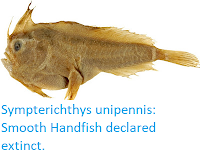The European Bison, Bison bonasus, Europe’s largest land Mammal, has moved from Vulnerable to Near Threatened thanks to continued conservation efforts, according to a press release issued by the International Union for the Conservation of Nature on 10 December 2020. With this update, 31 species also move into the Extinct category, and all of the world’s Freshwater Dolphin species are now threatened with extinction.
There are now 128 918 species on the International Union for the Conservation of Nature's Red List of Threatened Species, of which 35,765 are threatened with extinction.
'The European Bison and twenty-five other species recoveries documented in today’s IUCN Red List update demonstrate the power of conservation,' said Bruno Oberle, International Union for the Conservation of Nature's Director General. 'Yet the growing list of Extinct species is a stark reminder that conservation efforts must urgently expand. To tackle global threats such as unsustainable fisheries, land clearing for agriculture, and invasive species, conservation needs to happen around the world and be incorporated into all sectors of the economy.'
'The conservation successes in today’s Red List update provide living proof that the world can set, and meet, ambitious biodiversity targets. They further highlight the need for real, measurable commitments as we formulate and implement the post-2020 global biodiversity framework,' said Jane Smart, Global Director of International Union for the Conservation of Nature's Biodiversity Conservation Group.
As a result of long-term conservation management, the wild population of European Bison, Bison bonasus, has grown from around 1800 in 2003 to over 6200 in 2019, justifying the move from Vulnerable to Near Threatened. The species survived only in captivity in the early 20th century, and was reintroduced to the wild in the 1950s. The largest subpopulations are now found in Poland, Belarus and Russia. There are currently 47 free-ranging European Bison herds. However, herds are largely isolated from one another and confined to non-optimal forest habitats, and only eight of them are large enough to be genetically viable in the long term. The species remains dependent on ongoing conservation measures such as translocations of Bison to more optimal open habitats and reduction of Human-Bison conflicts.
'Historically, European Bison were reintroduced mostly to forest habitats, where they don’t find enough food in winter. However, when they move out of the forest into agricultural areas, they often find themselves in conflict with people. To reduce the conflict risk and the bison’s dependence on supplementary feeding, it will be important to create protected areas that include open meadows for them to graze”, said Rafał Kowalczyk, co-author of the new assessment and member of the International Union for the Conservation of Nature's Bison Specialist Group.
With the Tucuxi, Sotalia fluviatilis, moving from Data Deficient to Endangered, all of the world’s Freshwater Dolphin species are now listed as threatened on the International Union for the Conservation of Nature's Red List. This small grey Dolphin species found in the Amazon river system has been severely depleted by incidental mortality in fishing gear, damming of rivers and pollution. Eliminating the use of gillnets, curtains of fishing net that hang in the water, and reducing the number of dams in Tucuxi habitat are priorities to enable numbers to recover. Enforcing the ban on the deliberate killing of Tucuxis is also essential.
The Lost Shark, Carcharhinus obsoletus, which was only formally described last year, enters the Red List as Critically Endangered (Possibly Extinct). The species was last recorded in 1934. Its habitat in the South China Sea has been extensively fished for more than a century and remains one of the most overexploited marine regions in the world. As it is unlikely that the species could have persisted under this heavy pressure, the Lost Shark may already be extinct.
All of the 17 Freshwater Fish species endemic to Lake Lanao and its outlet in the Philippines are now Extinct (15 species) or Critically Endangered (Possibly Extinct) (two species). The extinctions were caused by predatory introduced species, compounded by overharvesting and destructive fishing methods.
Three Central American Frog species have been newly declared Extinct. Additionally, twenty-two Frog species across Central and South America were listed as Critically Endangered (Possibly Extinct). The main driver of these drastic declines is Chytridiomycosis disease. Conservation efforts to protect critical habitat are helping populations of several other Amphibian species to recover. Among them is the Oaxaca Treefrog, Sarcohyla celata, which moved from Critically Endangered to Near Threatened thanks to actions by local communities in Mexico.
The Protea family has been comprehensively assessed with this update, revealing that 45% (637 of 1464 species) of these striking Flowering Plants that grow mainly across the Southern Hemisphere are Vulnerable, Endangered or Critically Endangered. Many of the species have highly restricted ranges, making them more vulnerable to the spread of invasive alien species, changes to natural fire cycles caused by Humans and linked with climate change, and loss of habitat to agriculture. The Protea family includes three Macadamia species, the same species that produce the farmed Macadamia nut crop, which have entered the International Union for the Conservation of Nature's Red List as threatened with extinction in the wild. The Macadamia Nut (Macadamia integrifolia) is listed as Vulnerable, while Macadamia ternifolia and Macadamia tetraphylla are listed as Endangered.
Oak trees have been comprehensively assessed, revealing that almost one third (31%, 113 of 430 species) are threatened with extinction. Nine Asian oaks enter the International Union for the Conservation of Nature's Red List already Critically Endangered (Possibly Extinct or Possibly Extinct in the Wild). The highest numbers of threatened species are in China and Mexico, followed by Viet Nam, the United States and Malaysia. Land clearance for agriculture and logging are the most common threats in China, Mexico and Southeast Asia. Invasive alien species and diseases and climate change are the key threats to Oaks in the United States.
See also...



Follow Sciency Thoughts on Facebook.
Follow Sciency Thoughts on Twitter.









